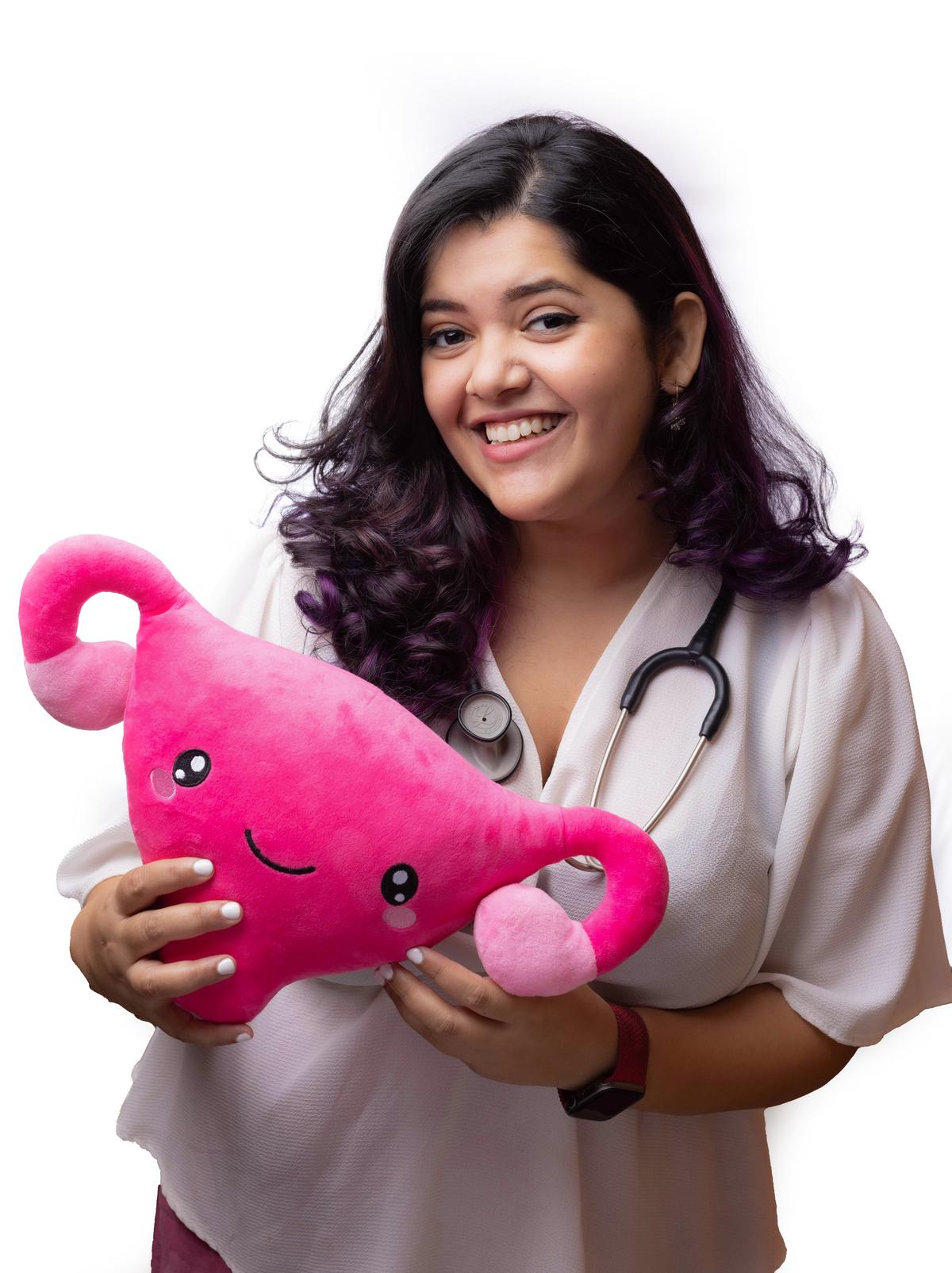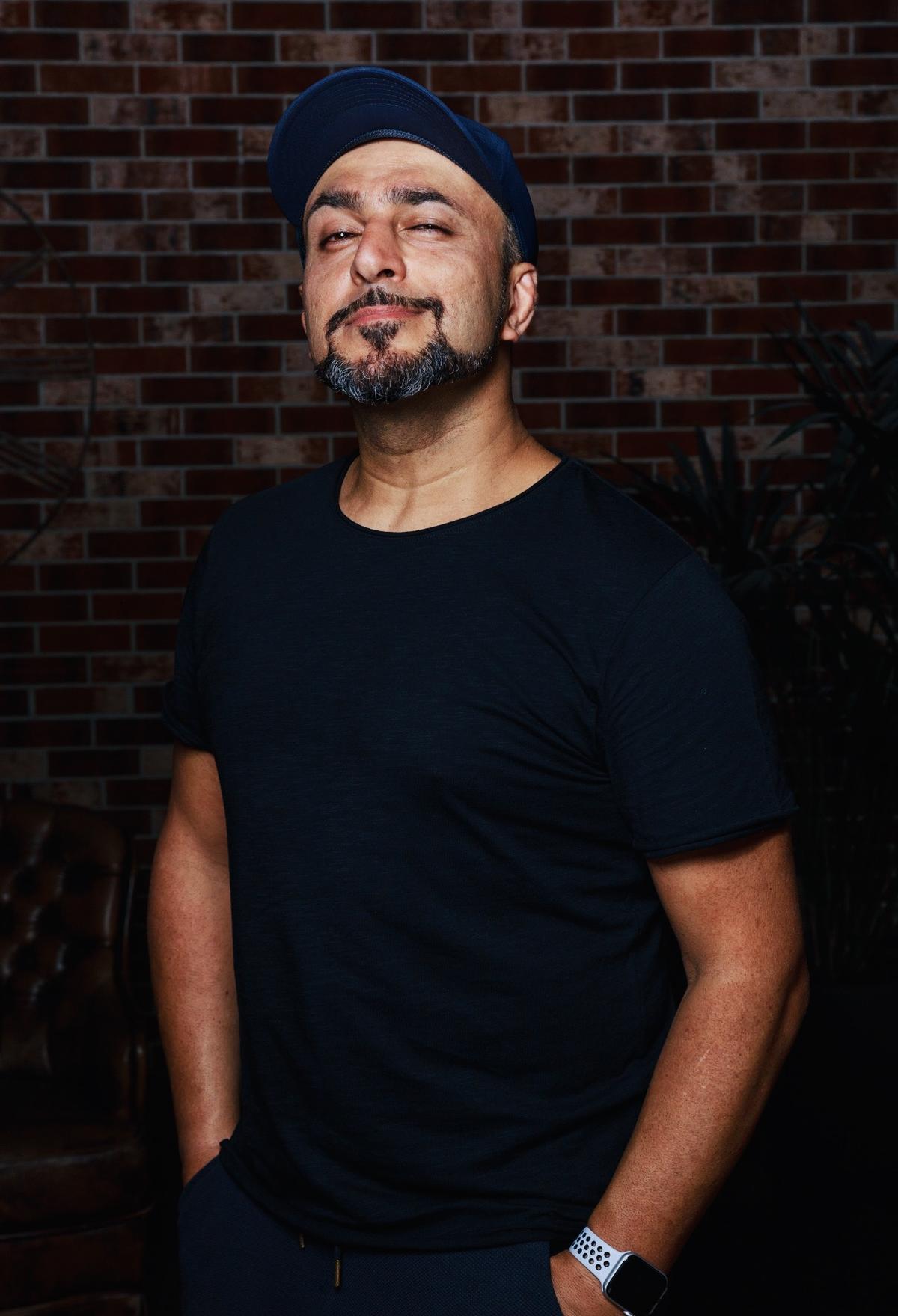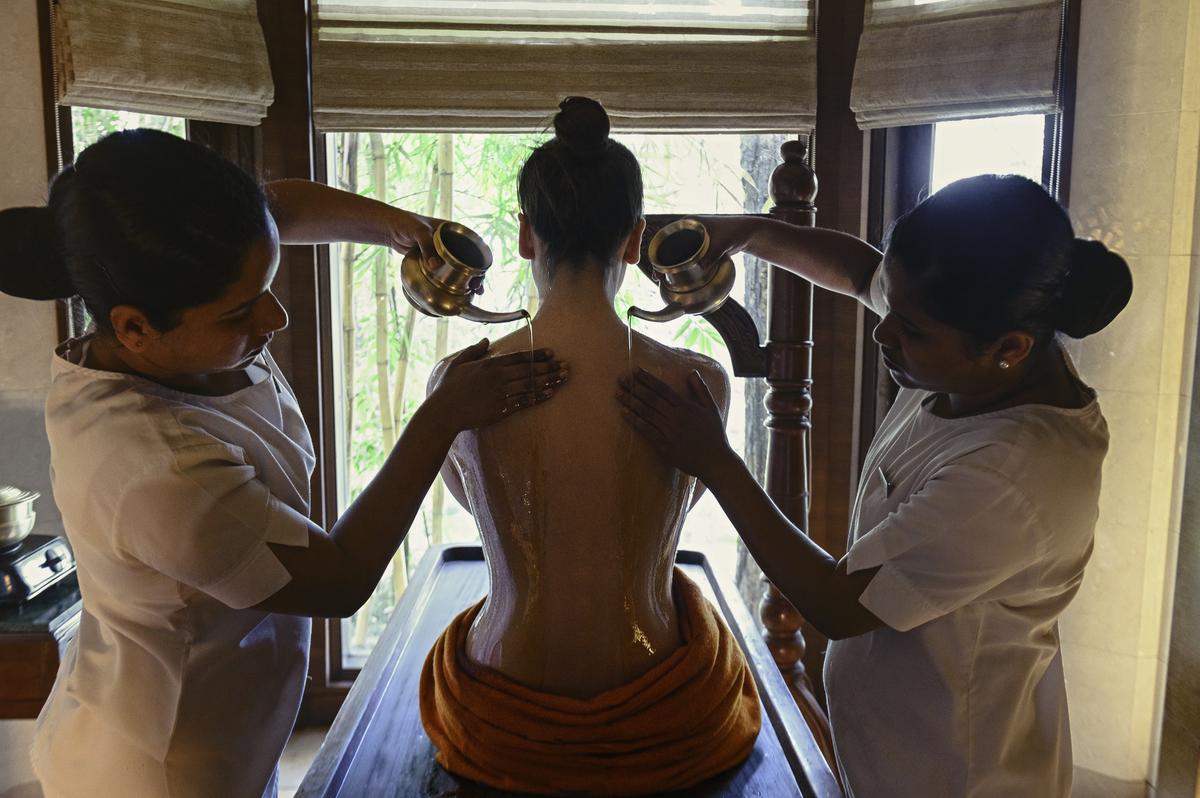
In 2024, the global wellness market touched $1.8 trillion, boosted, according to McKinsey’s ‘Future of Wellness’ report, by trends such as biomonitoring, wearables, and GenAI. But there’s another that needs mention: sexual wellness. Programmes around it have been gaining so much traction of late that open-minded travellers are hitting the road and hopping on flights to get reacquainted with themselves as sexual beings. So much so that Condé Nast Traveller included sexual wellness as one of its top travel trends for the year.
Proof can be seen in places across the globe, from Alicante in Spain, where SHA Wellness launched its sexual health unit a few months ago, to Uttarakhand, where Ananda in the Himalayas has a sexual reawakening programme. Pleasure mapping (helping people build relationships with their bodies and explore what brings pleasure) is being encouraged, and new programmes focused on exploring intimacy and desire are being introduced.
One of the treatments at SHA Wellness
As an early millennial, I must admit that learning about Ananda’s programme was a surprise. For most of my adult years, sex was a big deal and the lack of it was something to be embarrassed about. But according to professors Deblina Roy and Amit Newton of T.S. Mishra College of Nursing in Lucknow, who have published a paper in the Indian Journal of Health, Sexuality & Culture titled ‘Do millennials have less sex compared to Gen X?’, Indian millennials are, in fact, having less sex than previous generations. Several international studies (such as Monitoring the Future) have suggested that Gen Z too are engaging in less sexual activity. Is the world in a sex recession? If so, why?
Researchers suggest that many millennials are currently parenting young children and this life stage, coupled with work stress, is a big factor. Among Gen Z, social isolation of the pandemic, stress of lower economic opportunities, and use of technology are being cited as reasons. An increasing number are choosing to be celibate; and many are identifying as asexual. “I discovered that I’m asexual through conversations with my girlfriends,” says Sarah Andrade, 24, from Mumbai. “They spoke about being physically attracted to others and I realised that I had never had such feelings. I’m the plus in LGBTQ+.”
Less sex, but more desire
Interestingly, even though people are having less sex today, Rajan Bhonsle, M.D., Hon. Professor of Sexual Medicine, KEM Hospital & G.S. Medical College in Mumbai, doesn’t believe there is reduced desire. “As medicine and nutrition have progressed… I’m seeing better hormone levels across my patients which would translate to better libido. The real problem lies in our lifestyles and the redistribution of time compared to how we spent our days 30-40 years ago,” he says. “The avenues of entertainment have increased exponentially too.”
He recounts how he was once dissed in a newspaper office for suggesting a carefully-worded sex column to help people navigate difficulties in their intimate life. A few years later, he went on to write the column for the same newspaper when societal culture had evolved a bit.
He sees a huge difference today where talking about pleasure and sexual health is no longer taboo. He has had single female patients come in with questions about how to use sexual aids; married or partnered women who are dissatisfied with their husband’s performance in the bedroom (but stay in the marriage because of other reasons, such as companionship) and learn to take charge of their own pleasure.
Of toys and personal pleasure
“The conversation around sex toys and masturbation for women has gone mainstream,” says Tanaya Narendra, a practising doctor who also creates Instagram content in the sexual wellness space under the handle @dr_cuterus. “Post the pandemic, women have more agency in the bedroom and have also become more vocal about their desires and sex lives. They’re also seeing a lot of representation of this in mainstream media. Bollywood movies such as Lipstick Under My Burkha and Lust Stories are breaking the silence around women’s sex lives and pleasure.”

Tanaya Narendra
But the biggest testament to the idea of women prioritising their pleasure is the recent and rapid growth of the adult toys industry, which was valued at $112.45 million in 2023 with a 15% growth rate. The sale of sex toys and adult products increased by 65% after the first lockdown, according to a study by thatspersonal.com. One of the first players in the business in India, IMbesharam.com reported a 60% growth in 2021, 40% in 2022, 18% in 2023 and 20% in 2024 (so far).
“Prior to the pandemic, sex toys were considered a vulgar business but post-COVID, the category got much more credibility and relevance,” says founder Raj Armani. “When we started, it took us four years to sell 96,000 vibrators but post the pandemic, in 2022 alone, we sold 96,000. So far in 2024, we’ve sold 64,000. And this is just vibrators. 58% of our revenue comes from sex toys for women.”

Raj Armani
While earlier, it was ‘acceptable’ for women to not enjoy sex as much, that’s not the case anymore. “There’s more awareness of the orgasm gap and there’s less of a taboo around women’s self-pleasure. I believe using sex toys is an important way to get to know your own body, understand your own pleasure and prioritise it for yourself,” says Mumbai-based Nayantara Singh, who does research in gender, sexuality and technology. “More men are also now open to using sex toys with their partners, and see it as something that can help and even enhance their experience.”
There’s an interesting contrast between younger people having less sex, but women becoming more proactive about their sexual needs. Imbesharam reports that the age group of 45-60 years, which used to be their least engaged audience (barely contributing 3%-5% in revenue), is now contributing 12% of their revenue in 2024. So, menopausal women are also starting to pay attention to their pleasure.

“Over the next few years, we expect this trend [ sexual wellness travel] to pick up. There are two factors: one is that people today are more conscious of their health and open to self-care. The second is that more resorts and wellness retreats will pick up on this. As word gets around and access to these experiences increases, people will feel more comfortable exploring some of these options. I do know that some Indian brands are planning these programmes and experiences, but when they will roll out is anyone’s guess.”Salil DeshpandeCondé Nast Traveller India
Getting help in the Himalayas
My own journey is a reflection of the larger trend as described by Dr. Bhonsle. I met my husband at 24 and we had a movie-like romance until we got married at 28. There were no complaints on the sex front. But after getting diagnosed with endometriosis at 35, undergoing surgery and IVF at 36, and having a baby at 37, my sex life went through a dry spell. My gynaecologist suggested I get a hormonal IUD to manage the progressive disease and that resulted in a dip in my libido for a few months.
Meanwhile, my husband and I tried to work on our intimacy, but in fits and starts. A couple’s trip to the Maldives would feel exhilarating, but the exhausting lifestyle of working parents with a toddler would take over once we got back home. When my son turned four this year, I got the opportunity to try out a customised sexual reawakening programme at Ananda in the Himalayas. In all honesty, I wasn’t sure how holistic healing therapies were going to fix such a specific problem, but I decided to put my faith in the Rishikesh wellness retreat’s exceptional reputation.
I arrived in scenic Narendranagar — which has hosted the likes of talk show host Oprah Winfrey and actor Kate Winslet — with equal amounts of apprehension and curiosity. The first evening, I met Naresh Perumbuduri, who has trained in western medicine and is also a fourth-generation Ayurveda practitioner; he uses his knowledge and experience to create customised Ayurvedic programmes based on visitor’s complaints and their doshas (dominant vital energies). After a long conversation, he diagnosed me as a pitta-vata dosha.

At Ananda in the Himalayas
“Sex had a very clear place in ancient Indian healing systems and we never shied away from it,” he explained. “I’ve seen cases concerning libido, vigour and pelvic pain where we’ve been able to make a marked difference through Ayurveda, yoga and other holistic healing therapies.” He handed me my itinerary, which included personalised yoga and pranayama sessions, an Ayurvedic diet, and specific therapies such as kostha abhyanga (abdominal massage) and kashyadhara (where warm herbal decoctions are poured on the body after a gentle massage).
Four years ago, Ananda first started addressing hormonal imbalances in women as a remedy for lifestyle diseases such as PCOS and endometriosis. This led to them working on fertility enhancement programmes, and sexual well-being issues were a related field. They now have a sexual reawakening programme (approx. ₹50,000 per day — accommodation, consultation and treatments included) that is independent from their fertility enhancement.
Over the course of my stay, I began to dig a little deeper. I paid special attention to what was going on in my body, mind and soul. I woke early to jog through the verdant grounds, relaxed during my massages and therapies, and enjoyed their healthy food. However, the cornerstone of my experience was the yoga and pranayama I did with Malti Mehrish, who heads yoga at Ananda. She hypothetised that my C-section delivery had resulted in a pranic or energy block in my pelvis, and used breathwork to overcome it. The scientific explanation would be that the nerves cut during the surgery caused numbness around the scar.

Malti Mehrish
“The vagina has a very different connotation in English and contemporary culture, but in yoga, the yoni is considered sacred because it produces life,” she said. “That’s a very different way of looking at it. Sexuality had its rightful place in ancient Indian culture, the shame we associate with bodies and sex today is actually very western and only came with the culture of the colonisers.”
Malti guided me through a practice of psychic breathing in my lower body, and we did bandhas (kegel-like contractions of different muscles in the pelvis). My yoga practice with her reactivated and resensitised my pelvic region. I went from feeling helpless to being more in control of my body.
Holistic help and a change in mindset
It is natural for couples in their 50s to need help with being sexually active, but Issac Mathai, medical director at Soukya International Holistic Health Centre in Bengaluru, shares that they are “seeing many in their 30s and 40s having low libidos and less enthusiasm for intimacy. The reasons could be hormonal, stress-related, lack of interpersonal relationships, poor nutrition, too much time spent on smartphones. At Soukya, we use Ayurveda, yoga and homeopathy and have managed to help many people struggling with sexual wellness [programmes start from ₹40,000 per day].” The number of people asking for sexual wellness programmes at the centre has gone up over the last few years.
While getting away from the daily grind can help people tap into their sexuality, a luxury resort may not always be the right place to seek help. “These are serious medical conditions that need doctors with the appropriate knowledge and experience,” states Dr. Mathai. The best way to evaluate is to contact the properties directly and ask for a rundown of what’s included in the programme and confirm that they have qualified doctors.
What about those who can’t afford the time or money to travel or commit to such holistic treatments? “All it takes is a change in mindset,” assures Chennai-based psychiatrist Vijay Nagaswami. “People need to understand that the cause of low libido could well be their lifestyle, and know that these are fixable issues. [I advise my patients] to set apart some time for each other. Enhancing your emotional intimacy and sexual experimentation within the boundaries of a monogamous relationship would be the right way to go.”
Travelling for better sex
Travelling for sexual wellness — like my trip to the mountains — is resonating with people in a big way. And with the global sexual wellness market expected to reach $64.3 billion by 2030 (according to market research firm SkyQuest Technology), big players in the travel industry are getting on board.
Hotels around the world are building programmes and hosting retreats with experts such as sexuality educators, physiotherapists and yoga teachers to help guests improve their sex lives. For instance, in 2022, Six Senses Ibiza and St. Regis Punta Mita in Mexico held sexual wellness retreats, and W Brisbane ran a sexologist concierge service; and in 2023, Miraval Arizona in the U.S. started three different programmes geared toward sexual wellness. IntimacyMoons, an outfit created over eight years ago in the U.S. by sex therapist Marissa Nelson, is now in great demand, with business executives, entrepreneurs, same-sex couples and singles signing up for their retreats.
“Going by the number of retreats that are investing in sexual wellness programmes, there is a demand,” says Salil Deshpande, head of editorial content for Condé Nast Traveller India. “There is a definite increase with people signing up for self-care of all kinds, and sexual wellness is a small but significant part of that shift. From consultations with sexologists to physiotherapy and counselling, these programmes can get quite elaborate and diverse. Meanwhile, even smaller, thoughtful gestures can go a long way. Many hotels now offer complimentary intimacy kits in their rooms. My favourite is a family resort in Austria that offers 12-hour childcare from 9 to 9. Ask any stressed-out parent how exciting that is!”
I couldn’t agree with him more. I’ve come away from my time at Ananda with more awareness. In the last couple of months, I have started paying attention to my own pleasure and communicating it without hesitation to my husband. We are exploring new things together and while the changes are small, they’ve certainly improved the quality of our relationship.
The writer is a Mumbai-based author and travel journalist.





